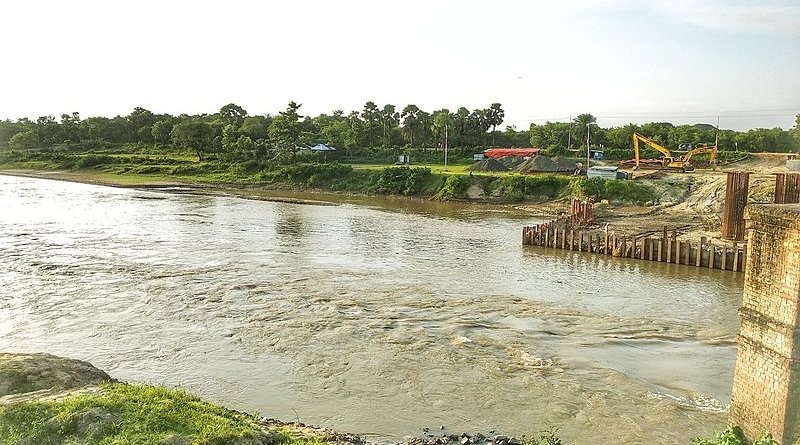Bipul Chatterjee & Prashant Sharma
Basin-wide management of trans-boundary rivers can act as a confidence-building measure for taking our bilateral relations to a higher level
Over the last several years, India and Bangladesh have improved their bilateral relations by several notches and there is a huge scope for them to foster integrated water resources management whose potential is still to be tapped fully. This is a medium that two countries can mainstream into their shared agenda of exploring new avenues of benefiting their people on the ground in a sustainable manner.
Not just that it can help them achieve cross-cutting Sustainable Development Goals by 2030 but also it will make their river-dependent economies, communities and ecosystems resilient from shocks such as the Covid-19 including imminent threats from climate change in future.
Along with 54 common rivers as part of the Ganges-Brahmaputra-Meghna (GBM) river system, India and Bangladesh share around 4096.7 kilometres of land and riverine borders. Put together, the GBM basin touches upon the human and environment flow requirements of around 630mn people across eastern South Asian countries of Bangladesh, Bhutan, India, Nepal and the Tibet in their north.
Scope and rationale for basin-wide management
According to the Food and Agriculture Organisation of the United Nations, a majority of the 630mn people living in the GBM basin depends on shared waters for lives and livelihoods. While Nepal and Bhutan are located in the Ganges (popularly known as the river Ganga in India) and Brahmaputra river basins, respectively, India with more than 60 percent area – over 1.7 million square kilometres of the GBM basin – shares contiguous upstream and downstream riparian linkages with Bangladesh with Ganga and Brahmaputra flowing into it as Padma and Jamuna.
The two rivers further converge with Meghna in Bangladesh, which connects the Barak river in the upstream in Assam, before they terminate together in the Bay of Bengal. These three great rivers along with their tributaries and distributaries including shared lakes and creeks in the Sundarbans offer incredible scope for undertaking a basin-wide approach for the management and development of riverine resources.
Those resources are essential not just for human life and biodiversity of the two countries and the BBIN plus the Tibet sub-region but also for sustainable agriculture, industrial, energy, navigation, drinking water and sanitation and other ecological considerations.
Underpinned with 54 trans-boundary rivers, a basin-wide approach can help transform mutual differences into shared opportunities. This will also help the two countries share the costs and benefits of their management. Constructive political and diplomatic efforts are being taken to sort out water management issues in a mutually acceptable manner.
For example, a shared understanding between India and Bangladesh to withdraw 1.82 cusecs of water from the Feni river for drinking purpose for the people of Sabroom town in Tripura has set a milestone. Similar arrangements are being endeavoured for other common rivers by collecting data and preparing water management arrangements.
These are high-impact, community-oriented measures and help people to understand the values of our bilateral cooperation. Along with an enhanced attention to augment inland waterways linkages under the bilateral protocols for inland water trade and transit including their linkages with coastal shipping, a robust cross-border trade infrastructure including that of border haats and potential for developing riverine border haats, among others, can be the basis of taking bilateral relations to the next level.
Besides them, depleting and polluting water resources, weaker drainage and waste water treatment systems, issues related with harmful impacts of dredging on aquifers, disputes on constructions of dams and barrages are some of the areas of mutual concern. They can be better addressed through a basin-wide management as against piece-meal approaches.
What needs to be done?
Not just that a basin-wide approach is helpful in addressing the demand and supply asymmetries for different sectoral needs, it can help prioritise the use of shared water resources, particularly in stressed situations. For that to happen there is an imminent need to widen the ambit of the Joint Rivers Commission to steer discussions and dialogues on comprehensive basin management concepts and capabilities.
This is possible when the two countries adopt a whole-of-government approach by engaging inland waterways authorities with agriculture and other relevant ministries including state and local government bodies.
They should also contemplate and contextualise holistic and sequential initiatives from global good practices such as those on the Mekong river, the Danube river, on how holistic trans-boundary basin management can foster a sustainable nexus for food, water and energy security. They can do so by encouraging greater civil society engagement other than using big data analytics and exponential technologies in informing their decisions.
Thus, it is time for India and Bangladesh to empower the Joint Rivers Commission with necessary legal and institutional frameworks so as to enhance its scope and scale for management of shared waters.
As the political determination to transform our bilateral relations as a role model for the Bay of Bengal region and the world is being manifested at all levels – diplomatic, security, trade and economics, civil society – the stage is set for a consensus towards the establishment of a cooperative governance framework for the management of basin-wide linkages.
Both countries have realised that such robustness is a product of our shared values and beliefs in discussions and dialogues under a rules-based order to resolve longstanding disputes. As a result, amicable resolution of land and maritime disputes between the two countries have effectively acted as confidence-building measures for continued deepening of our bilateral relations in every possible domain.
(Bipul Chatterjee is the Executive Director & Prashant Sharma Assistant Director of CUTS International, a global public policy think- and action-tank on trade, regulations and governance; Views are personal)
Image Source: data:image/jpeg
(The views expressed are the author's own and do not necessarily reflect the position of the organisation)

